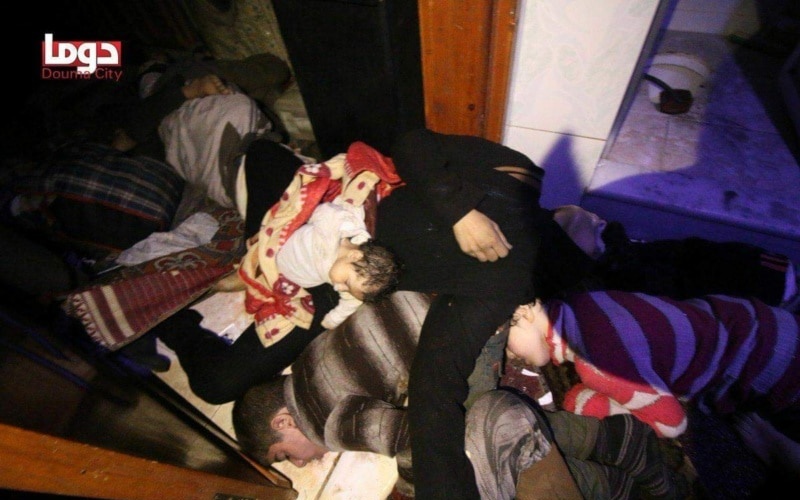Bodies of the 43 victims of the Assad regime’s chlorine attack on Douma, Syria, April 7, 2018
UPDATE, JAN 31:
Three days after the release of the report finding the Assad regime responsible for a deadly chlorine attack near Damascus in April 2018, the Russian Government has finally responded.
Significantly, the Foreign Ministry did not challenge the detailed assessment of the Organization for the Prohibition of Chemical Weapons, which found that a regime helicopter dropped a chlorine canister killing 43 civilians in an apartment block in Douma.
Instead, the Ministry responded to the report’s note that Moscow failed to provide any evidience supporting Russia’s claim of a staged incident by anti-Assad factions. It said Russia “considers this body illegitimate and… has no intention to cooperate with it out of principal considerations”.
The Ministry insisted, “The ITT [Investigations and Identification Team] was given a task (which it failed to fulfill) to justify the aggression of the US, the UK, and France against Syria.”
ORIGINAL ENTRY, JAN 28: The Organization for the Prohibition of Chemical Weapons has formally blamed the Assad regime for an April 2018 chlorine attack near Syria’s capital Damascus which killed 43 civilians.
Overcoming almost five years of obstacles, largely from the Assad regime and Russia, the OPCW’s IIT issued its report on Friday on the April 7, 2018 assault on Douma in the East Ghouta region.
Read Full Report
The slain civilians were in an apartment block, trapped by chlorine gas descending from a canister which had lodged in the roof.
The canister was dropped by an Assad regime helicopter during Russian-regime assaults trying to overrun the East Ghouta region. A second canister crashed through the roof of another building and landed in a bedroom, but failed to detonate.
On April 8, the day after the attack, anti-Assad factions surrendered in Douma, the last city holding out against the assault.
The Investigation and Identification Team, authorized in June 2019 by OPCW member states over the objection of Russia, concluded:
At least one Mi-8/17 helicopter of the Syrian Arab Air Force, departing from Dumayr airbase and operating under the control of the Tiger Forces, dropped two yellow cylinders which hit two residential buildings in a central area of the city.
The IIT identified four perpetrators in a regime air force unit, but did not make the names public.
Overcoming Russian and regime attempts to limit an investigation, a March 2019 report from the OPCW Fact Finding Mission established that chlorine had been used in the Douma attack.
See Syria Daily, March 2, 2019: Inspectors Point to Chlorine Attack on Douma by Assad Regime
Russia, the regime, and supportive activists in the West tried to bury the report with disinformation and propaganda. After the OPCW authorized the IIT’s mission determining responsibility, the pro-Assad groups stepped up the denunciation to undermine the inquiry and block any outcome.
Denying Syria’s Chemical Attacks, Attacking the Inspectors — The Douma Case
OPCW Director-General Ambassador Fernando Arias, a target of the pro-Assad propagandists, said Friday, “The world now knows the facts. It is up to the international community to take action, at the OPCW and beyond.”
The IIT’s report is based on assessment of 70 environmental and biomedical samples, 66 witness statements, 19,000 files, other verified data such as forensic analysis, satellite images, gas dispersion modelling, and trajectory simulations. The evidence was reviewed by IIT investigators, analysts, and several external independent experts.
Dismantling Disinformation of Russia and Assad Regime
The IIT was blocked by the Assad regime from visiting the sites of the attacks, despite repeated requests for meetings with regime officials “at their convenience and at a location of their choosing”.
However, the IIT examined multiple scenarios to test the claim of the Assad regime and Russia that the mass killing had been “staged by terrorist armed groups” and White Helmets rescuers with the support of Western states.
The IIT and external experts confirmed the Fact Finding Mission’s conclusion of the release of chlorine gas. The investigation then dismantled the Russian-regime disinformation of “staging”.
- “The spread of chlorine gas would be extremely difficult to mimic in a staging activity using bleach”
- “The ‘staging’ scenario is not supported by the chemical data, as well as in the pattern of how the relative levels of the chlorinated chemicals are distributed”
- “The practical requirements, the strict planning and the extensive work entailed by a ‘staging activity’ would have made it extremely laborious to be implemented, especially in a conflict-affected area”
- “All of these operations would have had to be performed, at both locations, according to a detailed plan in order to produce the concentration gradient and pattern observed in the results”
- “It would have been impossible to foresee what samples the FFM inspectors would have collected, and where, at each location”
The IIT also rebutted the conspiracy theory spread by Assad supporters that the 43 victims were killed elsewhere by anti-Assad groups and placed in the building. Its analysis concludes:
There are reasonable grounds to believe that the high number of fatalities observed in the building at Location 2 were as a result of severe symptoms experienced on the floors below the cylinder on the roof….
All models indicate that within three minutes of the release of chlorine from the cylinder, all floors within the building would have exceeded a concentration of chlorine which would lead to occupant death….Within 60 seconds the concentration of chlorine on the second floor would have led to occupant death.
The investigation further debunked the conspiracy theory of a “managed massacre” through an analysis of the bodies of the victims:
Neither witnesses nor medical personnel recount observing blunt force trauma or penetrating trauma in any of the fatalities. In addition, the IIT, in its assessment of verified
videos and images from Location 2, did not observe any signs of blunt force trauma orpenetrating trauma among the fatalities.Furthermore, fully established rigor mortis was observed in fatalities being carried out of Location 2 in the early hours of 8 April 2018, indicating that the time since death was no more than approximately 9 to 16 hours earlier.
Another conspiracy theory — that one of the chlorine cylinders had been placed in bedroom by anti-Assad factions — was dismantled through “available evidence, expert reports, and relevant trajectory simulations”.
The IIT summarized that the evidence and simulations “consistently pointed to both cylinders having been dropped from a low-flying helicopter from heights of at least 140 meters”.


[Reader’s Note: Commenter is wrong — the IIT report does have an analysis of components and contaminants, both in its reference to the Fact Finding Mission report of March 2019 and in additional information. The report also explains in detail “the reasonable grounds” why the chlorine present in the building, where 43 civilians died, came from the cylinder in the roof.]
The OPCW report does not contain any analysis of contaminants used in the production of chlorine gas that they claimed to have found in other locations.
REPORT OF THE OPCW FACT-FINDING MISSION IN SYRIA REGARDING AN INCIDENT IN SARAQIB: https://www.opcw.org/sites/default/files/documents/S_series/2018/en/s-1626-2018_e_.pdf
“In the raw material for the production of chlorine, bromide is an expected contaminant that is not always removed in the production process. This bromine/bromide is often present in downstream products, and therefore could be expected to be present, at significantly lower concentrations, whenever chlorine/chloride is detected. ”
There is no mention of finding any bromine/bromide in the environmental samples taken at Douma. The OPCW instead claim that the presence of the wood preservative and pesticide, tetrachlorophenol, was indicative of the use of chlorine gas: “The presence of TeCP clearly points to chlorine gas as being the chlorinating agent present at the scene, and in very high concentrations.” But tetrachlorophenol is present in drinking water according to the EPA: https://www.epa.gov/sites/default/files/2015-09/documents/m_528.pdf
The OPCW acknowledge, however, that, “chlorinated phenols could, theoretically, have been produced through the treatment of concrete blocks (at Location 2) and of different items at the scene (at Location 4) with bleach solution.”
No mention of actual concentration levels is provided in the annex of any of the three reports.
[Editor’s Note: Commenter is wrong on two counts — 1) the OPCW report does summarize the biomedical evidence for the killing of 43 civilians in the chlorine attack; 2) the OPCW has a detailed account of the funnelling of the chlorine from the roof through the building, concentrating the toxin and thus increasing the chance of death.
Other sections of the comment have been removed because they are disinformation or scientifically illiterate.]
https://www.opcw.org/sites/default/files/documents/2023/01/s-2125-2023%28e%29.pdf
“IIT considered a scenario (also discussed in detail by one of the experts consulted by the FFM) in which the cylinder bounced from the floor of the bedroom and arrived at the position at which it was found on the bed without human intervention……..A plausible mechanical explanation of how the cylinder may have landed on the bed after perforating the ceiling is that the cylinder penetrated the roof and, after a partial rotation, impacted on the floor at low velocity. Subsequently, it bounced and (further) rotated. That would explain why the orientation of the cylinder on the bed is opposite to its orientation on impact (about 180 degreees).”
The report goes on to discuss dissent within the OPCW due to the “Engineering Assessment” of Ian Henderson:
“Furthermore, despite one of the expert reports commissioned by the FFM describing a detailed scenario in which the cylinder bounces and rotates after penetrating the roof, the “Engineering Assessment” maintained that “it was not possible to establish a set of circumstances that were consistent with the observations, which would have resulted in the cylinder moving laterally within the room after the impact and bouncing onto the bed……the bed was not directly situated under the hole in the roof. Furthermore, the nose of the cylinder points in the opposite direction of the cylinder’s orientation upon impact……Nevertheless, based on the thorough analysis undertaken by the terminal ballistics expert it consulted, the IIT determined that it is conceivable that, after impact, the projectile may have rotated in a vertical plane and bounced off the floor.”
There is no biomedical analysis presented, from hair and blood samples whatsoever despite these being taken. There is also a claim about how chlorine allegedly dispersed from the top of the building (exposed to the air outside) to the lower floors where it supposedly poisoned residents:
“Furthermore, as chlorine is heavier than air, it would be expected to sink and, as a result, disperse in higher quantities below the point of impact on the roof, spreading to the floors below.”